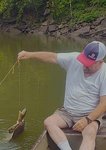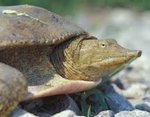I volunteered to fry fish for those who come to a class reunion at Houston, Mo in mid-September, so this past week my daughter and I took the old johnboat down to the river not far from …
This item is available in full to subscribers.
We have recently launched a new and improved website. To continue reading, you will need to either log into your subscriber account, or purchase a new subscription.
If you are a current print subscriber, you can set up a free website account by clicking here.
Otherwise, click here to view your options for subscribing.
Please log in to continue |
|


I volunteered to fry fish for those who come to a class reunion at Houston, Mo in mid-September, so this past week my daughter and I took the old johnboat down to the river not far from Lightnin’ Ridge and set a short trotline. We baited about 20 hooks with green sunfish Christy caught from my pond. We only caught a couple of catfish, but we hooked a huge soft-shell turtle that we initially thought was dead. He was likely 10 or 12 pounds, with a carapace (shell) about 18 to 20 inches in length.
When you set trotlines in just about any Ozark river, soft-shell turtles and hard-shell turtles are a problem. They are good about taking your live bait off a hook without getting hooked themselves. I don’t know how many times you catch them though because they get hooked by the leg or foot as they swim away. The one we caught the other night was hooked by the loose skin on his neck. The carapace on a soft-shell turtle isn’t really soft, it is pliable and leathery, different than the shell of any other water turtles. Therefore it is a turtle which is easier to clean than the big hard-shell snappers.
My grandfather, a riverman who didn’t often pass up anything good to eat no matter what it looked like or where he found it, could clean either type of turtle and he ate both, but the soft-shell was easier to clean and better tasting. He set lots and lots of trotlines and caught thousands of catfish up to 70 pounds, and sold and gave away lots of catfish meat in his life. But he never gave away turtle meat.
I never cleaned one, but watched and helped Grandpa and my dad do it. When I told my daughter, who is a fine naturalist and a science and high school biology teacher, how it was done, she decided to continue the tradition of her grandfathers and she cleaned it and kept the meat. It is said that there is seven types of meat on one of them, and while a soft-shell turtle has a variety of meat on it, I don’t know if I’d say there are that many. There is white meat and dark meat both. Christy is making several meals of it, and is very impressed about how good it is on the table. Many of her friends are repulsed by that, none of them inclined to look at the repulsiveness of a barnyard chicken or pigpen hog, which provides most of them a great meal quite often.
I was inclined to be that way as a 6- or 7-year-old boy helping Dad clean a turtle, or a duck or a squirrel, but I remember well my Dad telling me, “Son, there is nothing God created that is dirty inside. Most everything that is cleaned to eat has blood and entrails, and it is only objectionable if you don’t understand the natural way of life.”
Christy said that the turtle was about the most difficult thing she ever had to clean, but the meat is exceptionally good.
Soft shell turtles have a pointed snout and a reptilian eye that looks kind of evil. It is said one can live 50 years or so, but who knows for sure. It is also said they sleep at night and feed during the day. I KNOW that’s a bunch of baloney because we have caught many at night on night-crawlers via rod and reel. Their long necks and powerful jaws and long claws make them a problem if you don’t handle them with caution. If anyone were going to get bit by a turtle, it would have been me as a kid on the river. I did get bit by a couple of hard-shell snappers, but never a soft-shell. I never saw a soft-shell over 20 pounds either, if I can estimate weight accurately. But I could be wrong about that. Quite often I estimate a three-pound bass to be a five-pounder! The soft shell turtles I knew best laid a whole bunch of fairly hard, tough, round white eggs in the sand and lots of them got dug up and ate by things like raccoons and mink. The ones that hatched made great pets in an a big fishbowl until my mom found them. I think it is likely that you won’t read much about softshell turtles, as rivermen like me that set trotlines are a vanishing breed, and suburban outdoor writers of today don’t fiddle around much on rivers at night in the summer. But if you want to read about how to set trotlines and experiences I have had with trotlines over the years, you should get ahold of my 300 page book, recently published, entitled, “Recollection of an Old-Fashioned Angler”. You can see it, and order it, on my website, www.larrydablemont.com.
I am still wanting stories from folks who have had good or bad experiences with the Conservation Department and their wardens, for the book I am writing. Contact me at Box 22, Bolivar, Mo. 65613 or email lightninridge47@gmail.com